- Clone
- DATK32 (See other available formats)
- Regulatory Status
- RUO
- Other Names
- α4β7 Integrin, CD49d/β7, LPAM-1, ITGA4, ITGB7
- Isotype
- Rat IgG2a, κ
- Ave. Rating
- Submit a Review
- Product Citations
- publications
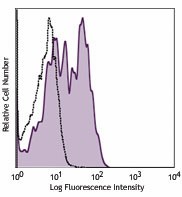
-

C57BL/6 mouse splenocytes stained with biotinylated LPAM-1 (clone DATK32), followed by Sav-PE.
| Cat # | Size | Price | Quantity Check Availability | Save | ||
|---|---|---|---|---|---|---|
| 120611 | 50 µg | 67€ | ||||
| 120612 | 200 µg | 137€ | ||||
DATK32 antibody is specific for a combinatorial determinate of integrin α4β7complex. Integrin α4β7 is composed of a 150 kD (α4 or CD49d) and a 130 kD (β7) heterodimer, also known as CD49d/β7 or LPAM-1. Belonging to the Ig superfamily, it is found on the majority of peripheral lymphocytes and subsets of thymocytes and bone marrow cells (including mast cell progenitors). Integrin α4β7 binds its ligands, VCAM-1 (CD106), MAdCAM-1 and fibronectin, and plays an important role in lymphocytes adhesion and the direction of migration of blood lymphocytes to the intestine and associated lymphoid tissues.
Product DetailsProduct Details
- Verified Reactivity
- Mouse
- Antibody Type
- Monoclonal
- Host Species
- Rat
- Immunogen
- TK1 cells
- Formulation
- Phosphate-buffered solution, pH 7.2, containing 0.09% sodium azide.
- Preparation
- The antibody was purified by affinity chromatography, and conjugated with biotin under optimal conditions.
- Concentration
- 0.5 mg/ml
- Storage & Handling
- The antibody solution should be stored undiluted between 2°C and 8°C. Do not freeze.
- Application
-
FC - Quality tested
- Recommended Usage
-
Each lot of this antibody is quality control tested by immunofluorescent staining with flow cytometric analysis. For flow cytometric staining, the suggested use of this reagent is ≤ 1.0 µg per million cells in 100 µl volume. It is recommended that the reagent be titrated for optimal performance for each application.
- Application Notes
-
Additional reported applications (for the relevant formats) include: in vitro and in vivo blocking of cell adhesion1-4, in vitro induction of TK1 cell aggregation1, immunoprecipitation4, and immunohistochemical staining of frozen sections5. It has been reported that the DATK32 mAb is able to block a4ß7 mediated lymphocyte adhesion to VCAM-1, MAdCAM-1, and fibronectin in vitro and in vivo.
- Application References
-
- Andrew DP, et al. 1994. J. Immunol. 153:3847. (Block)
- Berlin C, et al. 1993. Cell 74:185. (Block)
- Berlin-Rufenach C, et al. 1999. J. Exp. Med. 189:1467. (Block)
- Rivera-Nieves J, et al. 2005. J. Immunol. 174:2343. (Block, IP)
- Bogetto L, et al. 2000. Blood 95:2397. (IHC)
- RRID
-
AB_11204082 (BioLegend Cat. No. 120611)
AB_11204082 (BioLegend Cat. No. 120612)
Antigen Details
- Structure
- Integrin family, Ig superfamily, 150 kD/130 kD heterodimer
- Distribution
-
Majority of peripheral lymphocytes, subsets of thymocytes and bone marrow cells
- Function
- Lymphocyte adhesion
- Ligand/Receptor
- VCAM-1 (CD106), MAdCAM-1, fibronectin
- Biology Area
- Cell Biology, Immunology, Neuroscience, Synaptic Biology
- Molecular Family
- Adhesion Molecules, CD Molecules
- Antigen References
-
1. Andrew DP, et al. 1994. J. Immunol. 153:3847.
2. Berlin C, et al. 1994. Cell 74:185.
3. Gurish MF, et al. 2001 J. Exp. Med. 194:1243.
4. Hamann A, et al. 1994. J. Immunol. 152:3282. - Gene ID
- 311144 View all products for this Gene ID 25713 View all products for this Gene ID
- UniProt
- View information about LPAM-1 on UniProt.org
Related FAQs
- How many biotin molecules are per antibody structure?
- We don't routinely measure the number of biotins with our antibody products but the number of biotin molecules range from 3-6 molecules per antibody.
Other Formats
View All LPAM-1 Reagents Request Custom Conjugation| Description | Clone | Applications |
|---|---|---|
| Purified anti-mouse LPAM-1 (Integrin α4β7) | DATK32 | FC,Block,IP,IHC-F |
| PE anti-mouse LPAM-1 (Integrin α4β7) | DATK32 | FC |
| APC anti-mouse LPAM-1 (Integrin α4β7) | DATK32 | FC |
| Biotin anti-mouse LPAM-1 (Integrin α4β7) | DATK32 | FC |
| Brilliant Violet 421™ anti-mouse LPAM-1 (Integrin α4β7) | DATK32 | FC |
Compare Data Across All Formats
This data display is provided for general comparisons between formats.
Your actual data may vary due to variations in samples, target cells, instruments and their settings, staining conditions, and other factors.
If you need assistance with selecting the best format contact our expert technical support team.
-
Purified anti-mouse LPAM-1 (Integrin α4β7)

C57BL/6 mouse splenocytes stained with purified DATK32, foll... -
PE anti-mouse LPAM-1 (Integrin α4β7)
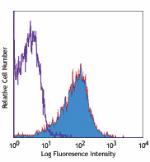
C57BL/6 mouse splenocytes stained with DATK32 PE 
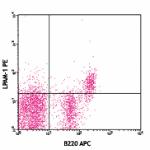
C57/B6 mouse bone marrow cells were surface stained with B22... -
APC anti-mouse LPAM-1 (Integrin α4β7)

C57BL/6 splenocytes stained with DATK32 APC 
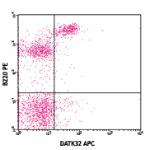
C57BL/6 mouse bone marrow cells were surface stained with B2... -
Biotin anti-mouse LPAM-1 (Integrin α4β7)
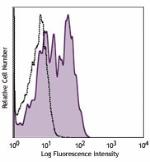
C57BL/6 mouse splenocytes stained with biotinylated LPAM-1 (... -
Brilliant Violet 421™ anti-mouse LPAM-1 (Integrin α4β7)

C57BL/6 mouse bone marrow cells were stained with anti-mouse...

 Login / Register
Login / Register 










Follow Us